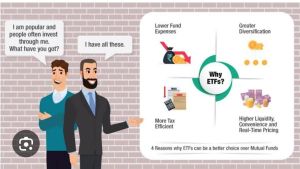
ETF Equity Traded Funds Investment Service
Get Price Quote
ETF's TRADING & INVESTMENT--- Table of Contents By James Chen Updated August 01, 2024 Reviewed by Gordon Scott Fact checked by Jiwon Ma Part of the Series Exchange-Traded Fund Guide for Beginners ETF Basics Exchange-Traded Fund (ETF): How to Invest and What It Is CURRENT ARTICLE 7 Best ETF Trading Strategies for Beginners Introduction to Exchange-Traded Funds (ETFs) 7 Easy-to-Understand ETFs to Replace A Savings Account Definition An exchange-traded fund is an investment vehicle that pools a group of securities into a fund. It can be traded like an individual stock on an exchange. What Is an Exchange-Traded Fund (ETF)? An exchange-traded fund (ETF) is a pooled investment security that can be bought and sold like an individual stock. ETFs can be structured to track anything from the price of a commodity to a large and diverse collection of securities. ETFs can even be designed to track specific investment strategies. Various types of ETFs are available to investors for income generation, speculation, and price increases, and to hedge or partly offset risk in an investor’s portfolio. The first ETF was the SPDR S&P 500 ETF (SPY), which tracks the S&P 500 Index. Key Takeaways An exchange-traded fund (ETF) is a basket of securities that trades on an exchange just like a stock does. ETF share prices fluctuate all day as the ETF is bought and sold; this is different from mutual funds, which only trade once a day after the market closes. ETFs offer low expense ratios and fewer broker commissions than buying the stocks individually. Types of ETFs Passive ETF: Passive ETFs aim to replicate the performance of a broader index—either a diversified index such as the S&P 500 or a more specific targeted sector or trend. Actively managed ETF: Do not target an index of securities, but rather have portfolio managers making decisions about which securities to include in the portfolio. Actively managed ETFs have benefits over passive ETFs but can be more expensive to investors. Bond ETF: Used to provide regular income to investors and distribution depends on the performance of underlying bonds which may include government, corporate, and state and local bonds, usually called municipal bonds. Unlike their underlying instruments, bond ETFs do not have a maturity date. Stock ETF: A basket of stocks that track a single industry or sector like automotive or foreign stocks. The aim is to provide diversified exposure to a single industry, one that includes high performers and new entrants with growth potential. Unlike stock mutual funds, stock ETFs have lower fees and do not involve actual ownership of securities. Industry or sector ETF: Funds that focus on a specific sector or industry. An energy sector ETF will include companies operating in that sector. Blackrock's iShares U.S. Technology ETF (IYW) mirrors the performance of the Russell 1000 Technology RIC 22.5/45 Capped Index and holds 1374 stocks of technology sector companies. Commodity ETF: Invest in commodities like crude oil or gold. Commodity ETFs can diversify a portfolio, making it easier to hedge market downturns. Holding shares in a commodity ETF is cheaper than physical possession of the commodity. Currency ETF: Track the performance of currency pairs consisting of domestic and foreign currencies. Currency ETFs can be used to speculate on the prices of currencies based on political and economic developments in a country. They are also used to diversify a portfolio or as a hedge against volatility in forex markets by importers and exporters. Bitcoin ETF: The spot Bitcoin ETF was approved by the SEC in 2024. These ETFs expose investors to bitcoin's price moves in their regular brokerage accounts by purchasing and holding bitcoins as the underlying asset and allowing them to buy shares of the fund. Bitcoin futures ETFs, approved in 2021, use futures contracts traded on the Chicago Mercantile Exchange and mimic the price movements of bitcoin futures contracts. Ethereum ETF: Spot ether ETFs provide a way to invest in ether, the currency native to the Ethereum blockchain, without directly owning the cryptocurrency. In May 2024, the SEC permitted Nasdaq, the Chicago Board Options Exchange, and the NYSE to list ETFs holding ether. And in July 2024, the SEC officially approved nine spot ether ETFs to begin trading on U.S. exchanges. Inverse ETF: Earn gains from stock declines by shorting stocks. Shorting is borrowing a stock, selling it while expecting a decline in value, and repurchasing it at a lower price. An inverse ETF uses derivatives to short a stock. Inverse ETFs are exchange-traded notes (ETNs) and not true ETFs. An ETN is a bond that trades like a stock and is backed by an issuer such as a bank. Leveraged ETF: A leveraged ETF seeks to return some multiples (e.g., 2× or 3×) on the return of the underlying investments. If the S&P 500 rises 1%, a 2× leveraged S&P 500 ETF will return 2% (and if the index falls by 1%, the ETF would lose 2%). These products use debt and derivatives, such as options or futures contracts, to leverage their returns.